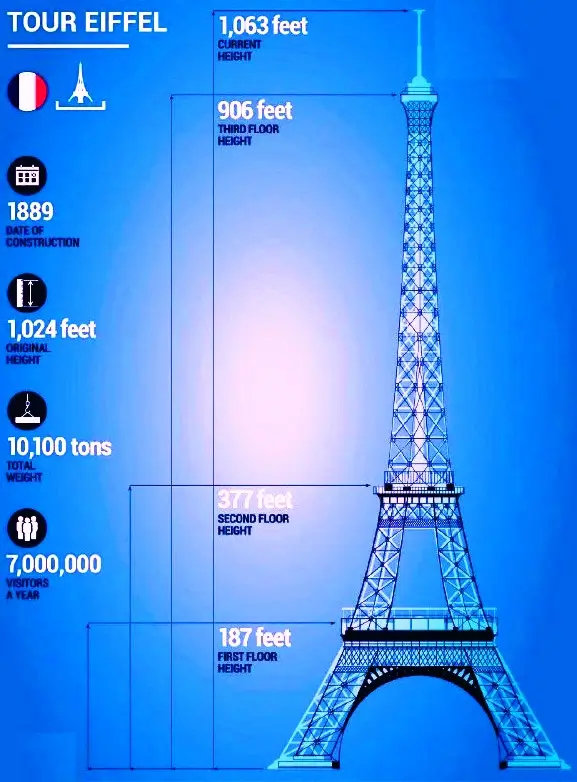What causes the Eiffel Tower to be slightly taller during the summer?
Eiffel Tower, French Tour Eiffel, Parisian landmark that is also a technological masterpiece in building-construction history. When the French government was organizing the International Exposition of 1889 to celebrate the centenary of the French Revolution, a competition was held for designs for a suitable monument.
More than 100 proposals submitted by the greatest international architects, the French government chose the one from Gustave Eiffel, the French engineer best known for his construction of metal bridges and for contributing to the design of the Statue of Liberty.
His proposal won for its originality and for its technical aspects. 18,038 iron parts and 2.5 million rivets were needed for its assembly.
Beyond the controversy, the work involved, and the complexity of the structure, the story of the Eiffel Tower is steeped in legends and curiosities.
Chief among these is the variability of its height.
The tower itself is 300 metres (984 feet) high. It rests on a base that is 5 metres (17 feet) high, and a television antenna atop the tower gives it a total elevation of 324 metres (1,063 feet).
Due to the thermal expansion of the metal that occurs during the summer time, the Tower grows an average of 15 centimetres (six inches) during the hottest months. The greatest growth on record occurred in 1976, when this heat-induced expansion added another 18 centimetres (seven inches) to the tower’s 324 metre height.
Another curious element regarding this beautiful monument is its repainting, a process that takes place, on average, every seven years. The tower has changed colors numerous times, moving from Venetian red, to ochre yellow, to chestnut brown, and finally to its current bronze, chosen as recently as 1968.
गर्मियों के दौरान एफिल टावर थोड़ा ऊंचा क्यों हो जाता है?
एफिल टॉवर, फ्रेंच टूर एफिल, पेरिस का ऐतिहासिक स्थल जो भवन निर्माण के इतिहास में एक तकनीकी उत्कृष्ट कृति भी है। जब फ्रांसीसी सरकार फ्रांसीसी क्रांति की शताब्दी मनाने के लिए 1889 की अंतर्राष्ट्रीय प्रदर्शनी का आयोजन कर रही थी, तो एक उपयुक्त स्मारक के डिजाइन के लिए एक प्रतियोगिता आयोजित की गई थी।
महानतम अंतरराष्ट्रीय वास्तुकारों द्वारा प्रस्तुत किए गए 100 से अधिक प्रस्तावों में से, फ्रांसीसी सरकार ने गुस्ताव एफिल में से एक को चुना, फ्रांसीसी इंजीनियर जो धातु पुलों के निर्माण और स्टैच्यू ऑफ लिबर्टी के डिजाइन में योगदान के लिए जाने जाते हैं।
उनका प्रस्ताव अपनी मौलिकता और तकनीकी पहलुओं के कारण जीता गया। इसके संयोजन के लिए 18,038 लोहे के हिस्सों और 2.5 मिलियन रिवेट्स की आवश्यकता थी।
विवाद, इसमें शामिल कार्य और संरचना की जटिलता से परे, एफिल टॉवर की कहानी किंवदंतियों और जिज्ञासाओं में डूबी हुई है।
इनमें से प्रमुख है इसकी ऊंचाई की परिवर्तनशीलता।
टावर स्वयं 300 मीटर (984 फीट) ऊंचा है। यह 5 मीटर (17 फीट) ऊंचे आधार पर स्थित है, और टावर के ऊपर एक टेलीविजन एंटीना इसे 324 मीटर (1,063 फीट) की कुल ऊंचाई देता है।
गर्मी के समय में होने वाले धातु के थर्मल विस्तार के कारण, टॉवर सबसे गर्म महीनों के दौरान औसतन 15 सेंटीमीटर (छह इंच) बढ़ता है। रिकॉर्ड पर सबसे बड़ी वृद्धि 1976 में हुई, जब इस ताप-प्रेरित विस्तार ने टावर की 324 मीटर ऊंचाई में 18 सेंटीमीटर (सात इंच) और जोड़ दिया।
इस खूबसूरत स्मारक के बारे में एक और दिलचस्प बात इसकी पुर्नरंगाई है, यह प्रक्रिया औसतन हर सात साल में होती है। टावर ने कई बार रंग बदले हैं, वेनिस लाल से गेरू पीला, चेस्टनट ब्राउन और अंततः अपने वर्तमान कांस्य में बदल गया, जिसे हाल ही में 1968 में चुना गया था।




